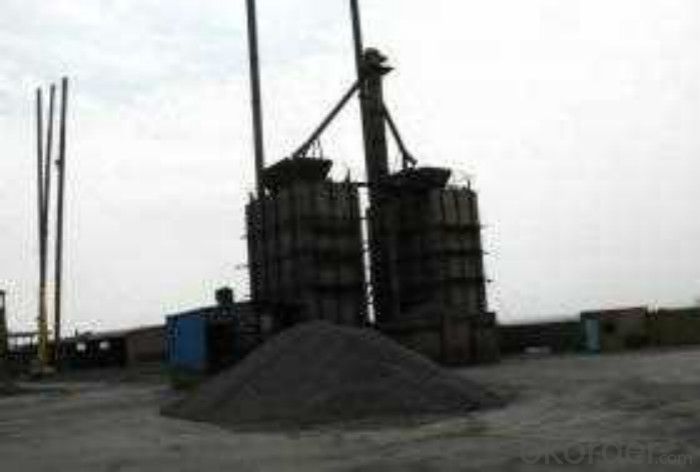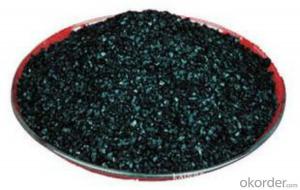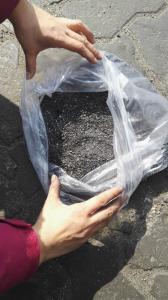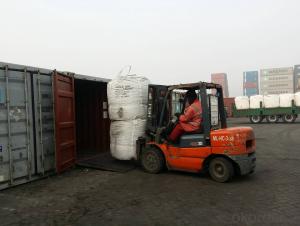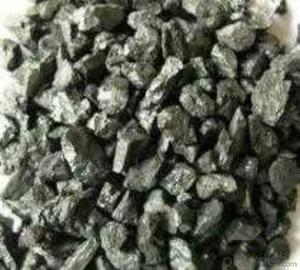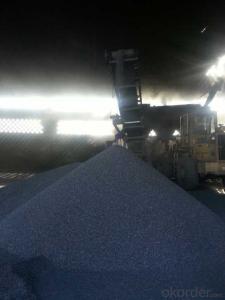FC90% Calcined Anthracite Coal as Injection Coke
- Loading Port:
- Tianjin
- Payment Terms:
- TT OR LC
- Min Order Qty:
- 21 m.t.
- Supply Capability:
- 9500 m.t./month
OKorder Service Pledge
OKorder Financial Service
You Might Also Like
Specification
Introduction
Calcined Petroleum Coke comes from delayed coke which extracted from oil refinery. Although Calcined Petroleum Coke contains a little bit higher level of sulfur and nitrogen than pitch coke, the price advantage still makes it widely used during steel-making and founding as a kind of carbon additive/carburant.
Features
Carbon Additive also called Calcined anthracite Coal, Gas Calcined Anthracite Coal, Carbon Raiser, Recarburizer, injection coke, charging coke and etc. It is playing more and more important role in the industry.
The main raw material of our Carbon Additive is Ningxia unique high quality Taixi anthracite, with characteristic of low ash and low sulfur. Carbon additive has two main usage, fuel and additive. When being used as the carbon additive of steel-smelting, and casting, the fixed carbon may achieve above 95%.
Best quality Taixi anthracite as raw materials through high temperature calcined at 1200-1250 ℃ for 24 hours by the DC electric calciner with results in eliminating the moisture and volatile matter from Anthracite efficiently, improving the density and the electric conductivity and strengthening the mechanical strength and anti-oxidation, It has good characteristics with low ash, low resistivity, low carbon and high density. It is the best material for high quality carbon products, it is used as carbon additive in steel industry or fuel.
Specifications
PARAMETER UNIT GUARANTEE VALUE | |||||
F.C.% | 95MIN | 94MIN | 93MIN | 92MIN | 90MIN |
ASH % | 4MAX | 5MAX | 6MAX | 7MAX | 8MAX |
V.M.% | 1 MAX | 1MAX | 1.5MAX | 1.5MAX | 1.5MAX |
SULFUR % | 0.5MAX | 0.5MAX | 0.5MAX | 0.5MAX | 0.5MAX |
MOISTURE % | 0.5MAX | 0.5MAX | 0.5MAX | 0.5MAX | 0.5MAX |
Pictures
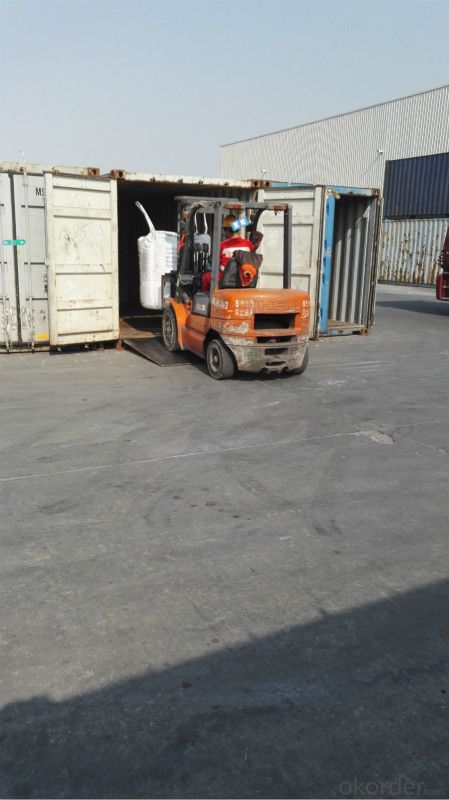

FAQ:
1. What is the packing?
In 25kg bag/ In jumbo bags without pallet/ Two jumbo bags with one pallet/ or as customers’ request
2. What is the production capacity?
10 thousand tons per month
3 What is payment term?
Irrevocable LC at sight/ 20% down payment by T/T and 80% against BL copy byT/T/ or to be discussed
4 What is the service?
We will send sample to the third party(CIQ, CCIC, SGS,BV or to be discussed) for checking, and present the test certificate and loading repot of shipment.
- Q: What are the impacts of carbon emissions on wildlife?
- Carbon emissions have a significant impact on wildlife and their ecosystems. One of the most direct impacts is through climate change caused by the release of greenhouse gases, primarily carbon dioxide, into the atmosphere. As carbon emissions contribute to the warming of the planet, it disrupts the delicate balance of ecosystems and affects biodiversity. One of the major consequences of climate change for wildlife is the alteration of habitats. Rising temperatures can lead to the loss of critical habitats such as coral reefs, mangroves, and polar ice caps, which are home to numerous species. This loss of habitat can result in the displacement or extinction of vulnerable species, disrupting entire food chains and ecological systems. Additionally, climate change can affect the timing and availability of resources for wildlife. Shifts in temperature and precipitation patterns can disrupt the timing of migration, breeding, and hibernation for many species. This can lead to mismatches between the availability of food sources and the needs of wildlife, ultimately impacting their survival and reproduction. Another impact of carbon emissions on wildlife is ocean acidification. When carbon dioxide dissolves in seawater, it forms carbonic acid, which lowers the pH of the oceans. Acidic waters can negatively affect marine organisms, particularly those with calcium carbonate shells or skeletons, such as corals, oysters, and certain types of plankton. This disruption in the marine food chain can have cascading effects on other marine species, including fish, birds, and marine mammals. Furthermore, carbon emissions contribute to air pollution, which can have direct impacts on wildlife. Pollutants such as nitrogen dioxide and sulfur dioxide can harm respiratory systems, impairing the health and reproductive success of animals. This can be particularly detrimental for species living in or near urban areas with high levels of pollution. In conclusion, carbon emissions have far-reaching impacts on wildlife. Climate change caused by carbon emissions disrupts habitats, alters resource availability, and contributes to ocean acidification. These changes can lead to the displacement or extinction of species, disrupt entire ecosystems, and impact the health and survival of wildlife. It is crucial to reduce carbon emissions and implement sustainable practices to mitigate these impacts and conserve biodiversity.
- Q: In Japanese, what's the difference between adding "carbon" and "sauce" after the name?
- Just like Chinese children, when they were young, they said, "Uncle", because they are small and articulate. It is easy to say "ball ball".
- Q: How are carbon markets regulated?
- Carbon markets are regulated through a combination of international agreements, national legislation, and the oversight of regulatory bodies. These regulations aim to ensure the transparency, integrity, and effectiveness of carbon trading activities. They often include requirements for the accurate measurement and reporting of emissions, the establishment of reliable registries, the accreditation of market participants, and the enforcement of compliance mechanisms.
- Q: We need to make a poster... Of the 27 essential elements of the human body, I am in charge of carbon! I haven't found it for a long time! Who can help me? Urgent!!!!!!Can you find something very specific? Thank you
- The three to four billion years of life symphony, whose theme is the evolution of carbon chemistry.
- Q: What are the consequences of increased carbon emissions on forest ecosystems?
- Increased carbon emissions have significant consequences on forest ecosystems. One of the most notable impacts is the alteration of the climate and weather patterns. The excessive carbon dioxide in the atmosphere traps heat, leading to global warming. This rise in temperature can disrupt the delicate balance of forest ecosystems. Warmer temperatures can cause shifts in the distribution and composition of tree species, as some may struggle to adapt to the changing conditions. Another consequence of increased carbon emissions is the acidification of rainwater. When carbon dioxide combines with water vapor, it forms carbonic acid, which can fall as acid rain. Acid rain has detrimental effects on forest ecosystems, as it leaches important nutrients from the soil and damages tree leaves and other vegetation. This can weaken the overall health of the forest and make them more susceptible to diseases and pests. Furthermore, increased carbon emissions contribute to the intensification of wildfires. Higher temperatures and drier conditions provide the perfect environment for fires to spread and become more frequent. Forests that have evolved to withstand natural fire regimes may struggle to cope with the increased intensity and frequency of these fires. This can lead to the loss of biodiversity, destruction of habitat, and long-term degradation of forest ecosystems. Lastly, increased carbon emissions contribute to the phenomenon known as ocean acidification, where excess carbon dioxide is absorbed by the oceans. This acidification can affect the health of coastal and marine ecosystems, which are intricately connected to forest ecosystems. Many forest ecosystems, such as mangroves and salt marshes, provide vital nursery habitats for marine species. If these forest ecosystems decline due to carbon emissions, it can have cascading effects on the health and productivity of coastal and marine ecosystems. Overall, increased carbon emissions have far-reaching consequences on forest ecosystems. It alters climate patterns, causes acid rain, intensifies wildfires, and affects coastal and marine ecosystems. These impacts not only harm the trees and vegetation within the forests but also disrupt the delicate balance of the entire ecosystem, leading to loss of biodiversity and long-term degradation. It is crucial to mitigate carbon emissions and promote sustainable practices to minimize these consequences and preserve the health and integrity of forest ecosystems.
- Q: How is carbon used in the agricultural industry?
- Carbon is widely used in the agricultural industry for various purposes. One of the main uses of carbon in agriculture is as a soil amendment. Adding carbon-rich organic matter, such as compost or manure, to the soil improves its structure, fertility, and overall health. This is because carbon helps to increase the soil's ability to retain moisture, nutrients, and beneficial microorganisms, which are essential for plant growth. In addition to soil amendment, carbon is also used in the form of carbon dioxide (CO2) for greenhouse enrichment. In controlled environments like greenhouses, plants require a higher concentration of CO2 to enhance their growth and productivity. Carbon dioxide is released into the greenhouse to maintain optimal levels, which promotes photosynthesis and accelerates plant growth. Moreover, carbon-based fertilizers are commonly used in agriculture. These fertilizers, such as urea or ammonium nitrate, provide essential nutrients to crops and enhance their productivity. Carbon is an integral component of these fertilizers, aiding in the controlled release of nutrients and their effective uptake by plants. Furthermore, carbon is utilized in the production of pesticides and herbicides. Many of these agricultural chemicals contain carbon compounds that are specifically designed to target and control pests, diseases, and weeds that can harm crops. Carbon-based chemicals are often used because of their effectiveness and ability to break down naturally without causing long-term harm to the environment. Overall, carbon plays a crucial role in the agricultural industry by improving soil fertility, enhancing plant growth, and aiding in pest control. Its versatile applications make it an essential resource for sustainable and efficient farming practices.
- Q: Emerald garden high carbon tempered metal
- 2.1 businessmen in the lower right corner. After 2.2, on an island below. Go and eat the merchant and bring him home. Kill the dragon. Be sure to hurry. The merchant fell off (I don't recommend it). You can also put a red dragon below killed off 2 Dragon eggs. Called red dragon, the businessman to eat, then at home, do not ignore it, he died, a businessman has come out. Get around the enemy base!
- Q: How does carbon affect the quality of indoor air?
- Carbon can have a significant impact on the quality of indoor air. One of the main contributors to carbon in indoor air is carbon dioxide (CO2), which is produced through the process of respiration by humans and animals. High levels of CO2 can cause discomfort, as it can lead to feelings of drowsiness, headaches, and difficulty concentrating. In addition to CO2, carbon monoxide (CO) is another carbon compound that can be present in indoor air, mainly due to the incomplete combustion of fossil fuels in stoves, fireplaces, and furnaces. Carbon monoxide is highly toxic and can be life-threatening if present in high concentrations. Apart from these direct sources of carbon, indoor air can also be affected by volatile organic compounds (VOCs), such as formaldehyde, benzene, and toluene. These VOCs are released from various sources like building materials, furniture, cleaning products, and tobacco smoke. They can have adverse health effects, including eye, nose, and throat irritation, headaches, dizziness, and in some cases, even long-term health risks like cancer. To maintain good indoor air quality, it is essential to monitor and control the levels of carbon compounds in the air. Proper ventilation is crucial to ensure fresh air circulation and reduce the concentration of CO2 and other pollutants. Regular maintenance and inspection of fuel-burning appliances can prevent the build-up of carbon monoxide. Using low-VOC or VOC-free materials and products, as well as avoiding smoking indoors, can help minimize the release of harmful carbon compounds.
- Q: Stability, primary carbon, two carbon, three carbon, four carbon
- From a variety of hydrogen is substituted alkyl free radicals generated in terms of difficulty order can have free radicals for the formation of tertiary carbon free radical secondary carbon free primary carbon free radicals. Alkyl radicals generated methyl easily, can be explained from two aspects: (1) different required to form free radicals when the fracture of C-H the energy, the (CH3) 3C-H fracture, the energy required for the smallest, most easily generated.
- Q: How does carbon impact the melting of polar ice caps?
- Carbon impacts the melting of polar ice caps primarily through the process of global warming. When carbon dioxide (CO2) and other greenhouse gases are released into the atmosphere, they trap heat and cause the Earth's temperature to rise. This increase in temperature leads to the melting of polar ice caps, as the excess heat causes the ice to melt at a faster rate than it can replenish. Additionally, carbon emissions contribute to the acidification of the oceans, which further accelerates the melting of ice.
Send your message to us
FC90% Calcined Anthracite Coal as Injection Coke
- Loading Port:
- Tianjin
- Payment Terms:
- TT OR LC
- Min Order Qty:
- 21 m.t.
- Supply Capability:
- 9500 m.t./month
OKorder Service Pledge
OKorder Financial Service
Similar products
Hot products
Hot Searches
Related keywords


